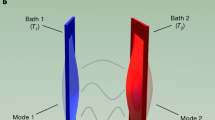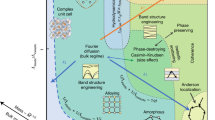Abstract
Thermal dissipation at the active region of electronic devices is a fundamental process of considerable importance1,2,3. Inadequate heat dissipation can lead to prohibitively large temperature rises that degrade performance4,5,6,7, and intensive efforts are under way to mitigate this self-heating8,9,10,11,12. At room temperature, thermal resistance is due to scattering, often by defects and interfaces in the active region, that impedes the transport of phonons. Here, we demonstrate that heat dissipation in widely used cryogenic electronic devices13,14,15,16 instead occurs by phonon black-body radiation with the complete absence of scattering, leading to large self-heating at cryogenic temperatures and setting a key limit on the noise floor. Our result has important implications for the many fields that require ultralow-noise electronic devices.
This is a preview of subscription content, access via your institution
Access options
Subscribe to this journal
Receive 12 print issues and online access
$259.00 per year
only $21.58 per issue
Buy this article
- Purchase on Springer Link
- Instant access to full article PDF
Prices may be subject to local taxes which are calculated during checkout



Similar content being viewed by others
References
Cahill, D. G. et al. Nanoscale thermal transport. II. 2003–2012. Appl. Phys. Rev. 1, 011305 (2014).
Pop, E., Sinha, S. & Goodson, K. E. Heat generation and transport in nanometer-scale transisitors. Proc. IEEE 94, 1587–1601 (2006).
Moore, A. L. & Shi, L. Emerging challenges and materials for thermal management of electronics. Mater. Today 17, 163–174 (April, 2014).
Trew, R., Green, D. & Shealy, J. AlGaN/GaN HFET reliability. IEEE Microw. Mag. 10, 116–127 (2009).
Kuzmik, J. et al. Self-heating phenomena in high-power III-N transistors and new thermal characterization methods developed within EU project TARGET. Int. J. Microw. Wirel. Technol. 1 (Special issue 02), 153–160 (2009).
Cho, J., Li, Z., Asheghi, M. & Goodson, K. E. Annual Review of Heat Transfer (Belsevere, 2014).
Weinreb, S. Low-noise cooled GASFET amplifiers. IEEE Trans. Microw. Theory Tech. 28, 1041–1054 (1980).
Yan, Z., Liu, G., Khan, J. M. & Balandin, A. A. Graphene quilts for thermal management of high-power GaN transistors. Nature Commun. 3, 827 (2012).
Su, Z. et al. Layer-by-layer thermal conductivities of the group III nitride films in blue/green light emitting diodes. Appl. Phys. Lett. 100, 201106 (2012).
Sun, J. et al. Thermal management of AlGaN-GaN HFETs on sapphire using flip-chip bonding with epoxy underfill. IEEE Electron Device Lett. 24, 375–377 (2003).
Kidalov, S. V. & Shakhov, F. M. Thermal conductivity of diamond composites. Materials 2, 2467–2495 (2009).
Subrina, S., Kotchetkov, D. & Balandin, A. A. Heat removal in silicon-on-insulator integrated circuits with graphene lateral heat spreaders. IEEE Electron Device Lett. 30, 1281–1283 (2009).
Pospieszalski, M. Extremely low-noise amplification with cryogenic FETs and HFETs: 1970–2004. IEEE Microw. Mag. 6, 62–75 (2005).
Wilson, C. M. Observation of the dynamic Casimir effect in a superconducting circuit. Nature 479, 376–379 (2011).
Delahaye, J. et al. Low-noise current amplifier based on mesoscopic Josephson junction. Science 299, 1045–1048 (2003).
Teufel, J. D. et al. Sideband cooling of micromechanical motion to the quantum ground state. Nature 475, 359–363 (2011).
Casimir, H. Note on the conduction of heat in crystals. Physica 5, 495–500 (1938).
Klitsner, T., VanCleve, J. E., Fischer, H. E. & Pohl, R. O. Phonon radiative heat transfer and surface scattering. Phys. Rev. B 38, 7576–7594 (1988).
Schleeh, J., Rodilla, H., Wadefalk, N., Nilsson, P. & Grahn, J. Characterization and modeling of cryogenic ultralow-noise InP HEMTs. IEEE Trans. Electron Devices 60, 206–212 (2013).
Pospieszalski, M. Modeling of noise parameters of MESFETs and MODFETs and their frequency and temperature dependence. IEEE Trans. Microw. Theory Tech. 37, 1340–1350 (1989).
Yang, R., Chen, G., Laroche, M. & Taur, Y. Simulation of nanoscale multidimensional transient heat conduction problems using ballistic-diffusive equations and phonon Boltzmann equation. J. Heat Transfer 127, 298–306 (2005).
Jeng, M-S., Yang, R., Song, D. & Chen, G. Modeling the thermal conductivity and phonon transport in nanoparticle composites using Monte Carlo simulations. J. Heat Transfer 130, 042410 (2008).
Sinha, S., Pop, E., Dutton, R. W. & Goodson, K. E. Non-equilibrium phonon distributions in sub-100 nm silicon transistors. J. Heat Transfer 128, 638–647 (2006).
Péraud, J-P. M. & Hadjiconstantinou, N. G. An alternative approach to efficient simulation of micro/nanoscale phonon transport. Appl. Phys. Lett. 101, 153114 (2012).
Peterson, R. B. Direct simulation of phonon-mediated heat transfer in a Debye crystal. J. Heat Transfer 116, 815–822 (1994).
Chen, G. Thermal conductivity and ballistic phonon transport in cross-plane direction of superlattices. Phys. Rev. B 57, 14958–14973 (1998).
Klemens, P. G. The thermal conductivity of dielectric solids at low temperatures (theoretical). Proc. R. Soc. Lond. A 208, 108–133 (1951).
Zhao, H. & Freund, J. B. Phonon scattering at a rough interface between two fcc lattices. J. Appl. Phys. 105, 013515 (2009).
Luckyanova, M. N. et al. Coherent phonon heat conduction in superlattices. Science 338, 936–939 (2012).
Sverdrup, P. G., Sinha, S., Asheghi, M., Uma, S. & Goodson, K. E. Measurement of ballistic phonon conduction near hotspots in silicon. Appl. Phys. Lett. 78, 3331–3333 (2001).
Gu, D., Randa, J., Billinger, R. & Walker, D. K. Measurement and uncertainty of a cryogenic low-noise amplifier with noise temperature below 2 K. Radio Sci. 48, 344–351 (2013).
Mateos, J., González, T., Pardo, D., Hoel, V. & Cappy, A. Monte Carlo simulator for the design optimization of low-noise HEMTs. IEEE Trans. Electron Devices 47, 1950–1956 (2000).
Rodilla, H. et al. Cryogenic performance of low-noise InP HEMTs: A Monte Carlo study. IEEE Trans. Electron Devices 60, 1625–1631 (2013).
Sinha, S. & Goodson, K. E. Thermal conduction in sub-100nm transistors. Microelectron. J. 37, 1148–1157 (2006).
Acknowledgements
The authors thank S. Weinreb for useful discussions. I.I-d-l-T. and J.M. were partially supported by the Spanish MINECO through project TEC2013-41640-R and by the Consejeria de Educación de la Junta de Castilla y León through project SA052U13. J.S., N.W., P.A.N. and J.G. were supported by the GigaHertz Centre in a joint research project financed by the Swedish Governmental Agency of Innovation Systems (VINNOVA), Chalmers University of Technology, Omnisys Instruments AB, Wasa Millimeter Wave, Low Noise Factory and SP Technical Research Institute of Sweden. A.J.M. was supported by a Caltech startup fund and by the National Science Foundation under Grant no. CAREER CBET 1254213.
Author information
Authors and Affiliations
Corresponding author
Ethics declarations
Competing interests
The authors declare no competing financial interests.
Supplementary information
Supplementary Information
Supplementary Information (PDF 287 kb)
Rights and permissions
About this article
Cite this article
Schleeh, J., Mateos, J., Íñiguez-de-la-Torre, I. et al. Phonon black-body radiation limit for heat dissipation in electronics. Nature Mater 14, 187–192 (2015). https://doi.org/10.1038/nmat4126
Received:
Accepted:
Published:
Issue Date:
DOI: https://doi.org/10.1038/nmat4126
This article is cited by
-
Defect scattering can lead to enhanced phonon transport at nanoscale
Nature Communications (2024)
-
The Impact of Surface Passivation on Kapitza Resistance at the Interface Between a Semiconductor and Liquid Nitrogen
Journal of Low Temperature Physics (2023)
-
Self-heating hotspots in superconducting nanowires cooled by phonon black-body radiation
Nature Communications (2022)
-
Physics-informed deep learning for solving phonon Boltzmann transport equation with large temperature non-equilibrium
npj Computational Materials (2022)
-
Non-Fourier phonon heat conduction at the microscale and nanoscale
Nature Reviews Physics (2021)



